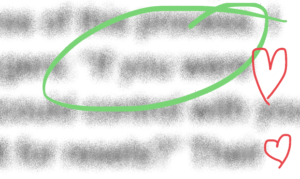“You’ll use this every day in your adult life.” Remember that from school? Math (true), science (yeah), note taking (big yep), history (oh yeah) …. We even had a few Junior Achievement classes: writing checks and account balancing, doing our taxes, and touch typing (big yeah). Heck, one guy who taught us how to visualize our futures by designing our own business card (I won five dollars!).
One thing that wasn’t on this list was drawing little hearts on my papers. While I don’t draw them every day, I do find I’m using them more often than expected these days.
My first developmental editor used a green pen to edit everyone’s work. Her philosophy? Red is a punitive color, left over from our school days (though most of my kids’ papers come home in a rainbow of colors thanks to the gel pen craze). But I use a red pen to show the love.

When I started editing my own work, then the work of others (I’ve been a lone writer the bulk of the last decade), I picked purple: I use it both in paper and electronic edits. Microsoft Word lets me change the color (handy), and in a pinch I can take a screenshot of something and mark up text with my finger on my phone.
But there’s more to editing than just picking a color of ink. When you have the time and overhead available, it can be a conversation.
My kids write in Google Docs. I shadow them at the editing stage, and make suggestions to help them craft stronger arguments. We sit on our computers and talk it through out loud, or pass drafts back and forth as time permits. I work, like a teaching editor should, by not doing it for them … but by peppering in questions and suggestions to help them think things through.
- How does this answer the main question asked?
- Does this provide enough background information?
- Can you think of a real-world example you’ve experienced to share here?
- I know you’re trying to say [this], but I think you need a bit more supporting information to draw the viewer a clearer picture ….
Hearing Clients’ Voices
Sometimes I’m the one getting edited for voice and tone, especially when I’m working with industry-specific subject matter experts and clients. I gather the meat of the information they need to share, the audience they need to share it with, and work on emulating the appropriate voice and tone for the content.
The voice might be an actual voice when I’m ghostwriting for an industry leader: professional, authoritative, their linguistic fingerprint in every section or call out. Or it can be tuned more generically, coming across as an authoritative tone in an industry-knowledgable way.
You’ll “hear” a professional services provider speaking to a decision maker, or a helpful voice guiding someone a little lost in a myriad of choices. The tone of anonymous, but knowledgable colleagues, may help readers think about a topic from an angle they’d not considered before.
The experts I’m helping know their lingo. They know the finer points of how the content we create together has to sound, and they edit me right back. We edit conversationally, making sure the content answers the audience’s questions, informs the readers appropriately, or otherwise meets the project goals.
Checking the Vitals One Last Time
At the end of it all, we give content one last check before it goes online. Most clients stage their work and let it sit for a few days. We wipe our minds clean of drafts and wrangling before we do that last review. We come back to it fresh before we release it to the world, checking tone, flow, and watching for dropped punctuation. Little purple marks fix these things, but then I get to drag out my heart pen.

I don’t heart something every time, but my favorite part is when I can. When a fresh look gives a client a bit of insight to add that makes the work shine. Then I’m not just sending back crossed out commas or duplicate words, I get to draw those little hearts on the surprises I love. Heart days are the best days.
If you’re looking for a writer or editor to help you reach your technical B2B or B2C audience, drop me a line, or learn more about editing conversations here.